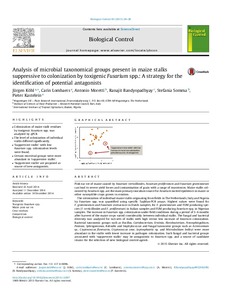| dc.contributor.author | Köhl, J. |
| dc.contributor.author | Lombaers, C. |
| dc.contributor.author | Moretti, A. |
| dc.contributor.author | Bandyopadhyay, Ranajit |
| dc.contributor.author | Somma, S. |
| dc.contributor.author | Kastelein, P. |
| dc.date.accessioned | 2019-12-04T10:57:56Z |
| dc.date.available | 2019-12-04T10:57:56Z |
| dc.date.issued | 2015 |
| dc.identifier.citation | Köhl, J., Lombaers, C., Moretti, A., Bandyopadhyay, R., Somma, S., & Kastelein, P. (2015). Analysis of microbial taxonomical groups present in maize stalks suppressive to colonization by toxigenic Fusarium spp.: a strategy for the identification of potential antagonists. Biological Control, 83, 20-28. |
| dc.identifier.issn | 1049-9644 |
| dc.identifier.uri | https://hdl.handle.net/20.500.12478/876 |
| dc.description.abstract | Pink ear rot of maize caused by Fusarium verticillioides, Fusarium proliferatum and Fusarium graminearum
can lead to severe yield losses and contamination of grain with a range of mycotoxins. Maize stalks colonized
by Fusarium spp. are the main primary inoculum source for Fusarium incited epidemics in maize or
other susceptible crops grown in rotation.
The colonization of individual maize stalks originating from fields in The Netherlands, Italy and Nigeria
by Fusarium spp. was quantified using specific TaqMan-PCR assays. Highest values were found for
F. graminearum and Fusarium avenaceum in Dutch samples, for F. graminearum and FUM producing species
(F. verticillioides and F. proliferatum) in Italian samples and FUM producing Fusarium spp. in Nigerian
samples. The increase in Fusarium spp. colonization under field conditions during a period of 3–6 months
after harvest of the maize crops varied considerably between individual stalks. The fungal and bacterial
diversity was analyzed for sub-sets of stalks with high versus low increase of Fusarium colonization.
Bacterial taxonomic groups such as Bacillus, Curtobacterium, Erwinia, Flavobacterium, Novosphingobium,
Pantoea, Sphingomonas, Rahnella and Staphylococcus and fungal taxonomic groups such as Acremomium
sp., Cryptococcus flavescens, Cryptococcus zeae, Leptosphaeria sp. and Microdochium bolleyi were more
abundant in the stalks with lower increase in pathogen colonization. Such fungal and bacterial groups
associated with ‘suppressive stalks’ may be antagonistic to Fusarium spp. and a source of candidate
strains for the selection of new biological control agents.Pink ear rot of maize caused by Fusarium verticillioides, Fusarium proliferatum and Fusarium graminearum
can lead to severe yield losses and contamination of grain with a range of mycotoxins. Maize stalks colonized
by Fusarium spp. are the main primary inoculum source for Fusarium incited epidemics in maize or
other susceptible crops grown in rotation.
The colonization of individual maize stalks originating from fields in The Netherlands, Italy and Nigeria
by Fusarium spp. was quantified using specific TaqMan-PCR assays. Highest values were found for
F. graminearum and Fusarium avenaceum in Dutch samples, for F. graminearum and FUM producing species
(F. verticillioides and F. proliferatum) in Italian samples and FUM producing Fusarium spp. in Nigerian
samples. The increase in Fusarium spp. colonization under field conditions during a period of 3–6 months
after harvest of the maize crops varied considerably between individual stalks. The fungal and bacterial
diversity was analyzed for sub-sets of stalks with high versus low increase of Fusarium colonization.
Bacterial taxonomic groups such as Bacillus, Curtobacterium, Erwinia, Flavobacterium, Novosphingobium,
Pantoea, Sphingomonas, Rahnella and Staphylococcus and fungal taxonomic groups such as Acremomium
sp., Cryptococcus flavescens, Cryptococcus zeae, Leptosphaeria sp. and Microdochium bolleyi were more
abundant in the stalks with lower increase in pathogen colonization. Such fungal and bacterial groups
associated with ‘suppressive stalks’ may be antagonistic to Fusarium spp. and a source of candidate
strains for the selection of new biological control agents. |
| dc.language.iso | en |
| dc.subject | Crop Residues |
| dc.subject | Biological Control |
| dc.subject | Maize |
| dc.subject | Fusarium |
| dc.title | Analysis of microbial taxonomical groups present in maize stalks suppressive to colonization by toxigenic Fusarium spp.: a strategy for the identification of potential antagonists |
| dc.type | Journal Article |
| dc.description.version | Peer Review |
| cg.contributor.crp | Maize |
| cg.contributor.affiliation | Plant Research International |
| cg.contributor.affiliation | Institute of Sciences of Food Production, Italy |
| cg.contributor.affiliation | International Institute of Tropical Agriculture |
| cg.coverage.region | Africa |
| cg.coverage.region | West Africa |
| cg.coverage.country | Nigeria |
| cg.isijournal | ISI Journal |
| cg.authorship.types | CGIAR and advanced research institutes |
| cg.iitasubject | Maize |
| cg.journal | Biological Control |
| cg.howpublished | Formally Published |
| cg.accessibilitystatus | Limited Access |
| local.dspaceid | 76375 |
| cg.identifier.doi | https://dx.doi.org/10.1016/j.biocontrol.2014.12.007 |

